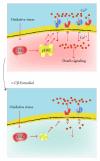Protective Action of Neurotrophic Factors and Estrogen against Oxidative Stress-Mediated Neurodegeneration
- PMID: 21776259
- PMCID: PMC3135156
- DOI: 10.1155/2011/405194
Protective Action of Neurotrophic Factors and Estrogen against Oxidative Stress-Mediated Neurodegeneration
Abstract
Oxidative stress is involved in the pathogenesis of neurodegenerative disorders such as Alzheimer's disease, Parkinson's disease, and Huntington's disease. Low levels of reactive oxygen species (ROS) and reactive nitrogen species (RNS) are important for maintenance of neuronal function, though elevated levels lead to neuronal cell death. A complex series of events including excitotoxicity, Ca(2+) overload, and mitochondrial dysfunction contributes to oxidative stress-mediated neurodegeneration. As expected, many antioxidants like phytochemicals and vitamins are known to reduce oxidative toxicity. Additionally, growing evidence indicates that neurotrophic factors such as brain-derived neurotrophic factor (BDNF) and estrogens significantly prevent neuronal damage caused by oxidative stress. Here, we review and discuss recent studies addressing the protective mechanisms of neurotrophic factors and estrogen within this system.
Figures



Similar articles
-
Oxidative stress, mitochondrial dysfunction and cellular stress response in Friedreich's ataxia.J Neurol Sci. 2005 Jun 15;233(1-2):145-62. doi: 10.1016/j.jns.2005.03.012. J Neurol Sci. 2005. PMID: 15896810 Review.
-
Neuroprotective role of polyphenols against oxidative stress-mediated neurodegeneration.Eur J Pharmacol. 2020 Nov 5;886:173412. doi: 10.1016/j.ejphar.2020.173412. Epub 2020 Aug 13. Eur J Pharmacol. 2020. PMID: 32771668 Review.
-
Pathogenesis of Neurodegenerative Diseases and the Protective Role of Natural Bioactive Components.J Am Nutr Assoc. 2024 Jan;43(1):20-32. doi: 10.1080/27697061.2023.2203235. Epub 2023 May 15. J Am Nutr Assoc. 2024. PMID: 37186678 Review.
-
Mitochondrial dysfunction and oxidative stress in Alzheimer's disease, and Parkinson's disease, Huntington's disease and Amyotrophic Lateral Sclerosis -An updated review.Mitochondrion. 2023 Jul;71:83-92. doi: 10.1016/j.mito.2023.05.007. Epub 2023 Jun 1. Mitochondrion. 2023. PMID: 37269968 Review.
-
Power Failure of Mitochondria and Oxidative Stress in Neurodegeneration and Its Computational Models.Antioxidants (Basel). 2021 Feb 3;10(2):229. doi: 10.3390/antiox10020229. Antioxidants (Basel). 2021. PMID: 33546471 Free PMC article. Review.
Cited by
-
Estrogens and gastroparesis: a clinical relevance.Dig Dis Sci. 2013 Jun;58(6):1449-51. doi: 10.1007/s10620-013-2683-0. Dig Dis Sci. 2013. PMID: 23625290 No abstract available.
-
Seizure-Induced Oxidative Stress in Status Epilepticus: Is Antioxidant Beneficial?Antioxidants (Basel). 2020 Oct 22;9(11):1029. doi: 10.3390/antiox9111029. Antioxidants (Basel). 2020. PMID: 33105652 Free PMC article. Review.
-
Selenium Nanoparticles in Protecting the Brain from Stroke: Possible Signaling and Metabolic Mechanisms.Nanomaterials (Basel). 2024 Jan 11;14(2):160. doi: 10.3390/nano14020160. Nanomaterials (Basel). 2024. PMID: 38251125 Free PMC article. Review.
-
Interactions of Aromatase and Seladin-1: A Neurosteroidogenic and Gender Perspective.Transl Neurosci. 2019 Nov 6;10:264-279. doi: 10.1515/tnsci-2019-0043. eCollection 2019. Transl Neurosci. 2019. PMID: 31737354 Free PMC article.
-
Spirulina maxima Extract Ameliorates Learning and Memory Impairments via Inhibiting GSK-3β Phosphorylation Induced by Intracerebroventricular Injection of Amyloid-β 1-42 in Mice.Int J Mol Sci. 2017 Nov 13;18(11):2401. doi: 10.3390/ijms18112401. Int J Mol Sci. 2017. PMID: 29137190 Free PMC article.
References
-
- Sakurada O, Kennedy C, Jehle J, Brown JD, Carbin GL, Sokoloff L. Measurement of local cerebral blood flow with iodo [14C] antipyrine. The American Journal of Physiology. 1978;234(1):H59–H66. - PubMed
-
- Cremer JE, Seville MP. Regional brain blood flow, blood volume, and haematocrit values in the adult rat. Journal of Cerebral Blood Flow and Metabolism. 1983;3(2):254–256. - PubMed
-
- Scremin OU, Sonnenschein RR, Rubinstein EH. Cholinergic cerebral vasodilatation: lack of involvement of cranial parasympathetic nerves. Journal of Cerebral Blood Flow and Metabolism. 1983;3(3):362–368. - PubMed
-
- Sokoloff L, Reivich M, Kennedy C, et al. The [C]deoxyglucose method for the measurement of local cerebral glucose utilization: theory, procedure, and normal values in the conscious and anesthetized albino rat. Journal of Neurochemistry. 1977;28(5):897–916. - PubMed
-
- Sokoloff L. Localization of functional activity in the central nervous system by measurement of glucose utilization with radioactive deoxyglucose. Journal of Cerebral Blood Flow and Metabolism. 1981;1(1):7–36. - PubMed
LinkOut - more resources
Full Text Sources
Research Materials
Miscellaneous

